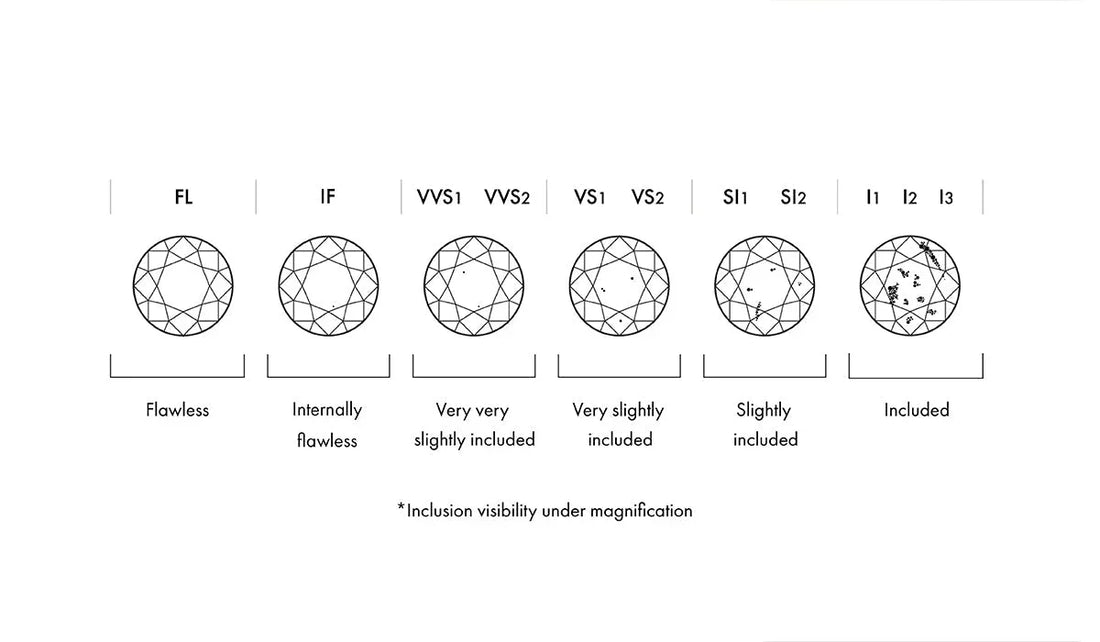
Diamond Clarity Explained: Your Complete Chart for Quality Comparison
Share
You've probably heard jewellers rave about clarity—it’s one of the "Four Cs," after all. They’ll show you charts, pull out magnifying tools, and talk about “flawless” diamonds like they’re the holy grail. But here’s a question: can you even see those microscopic flaws with your naked eye?
The truth is, clarity is one of the most misunderstood aspects of buying diamonds. Jewellers love to emphasise it, often steering you toward more expensive options. But here’s the catch: they might not be telling you everything.
What if I told you that you could save a significant amount of money without sacrificing the beauty of your diamond? Sounds too good to be true, right?
Well, let’s cut through the sparkle and dive into what clarity means, why it’s hyped up, and—most importantly—what you need to know before buying. So, are you ready? then let's dive into those secrets that will surely help you.
Diamond Clarity: Why Does It Matter?
Clarity refers to the presence of tiny imperfections inside or on the surface of a diamond. Inside the diamond, these imperfections are called inclusions—think tiny crystals, feathers, or clouds that formed when the diamond was created billions of years ago.
On the surface, you might find blemishes like scratches or nicks. In general, the lower the number of these imperfections, the higher the clarity grade.
Diamonds are graded on a scale by the Gemological Institute of America (GIA), from Flawless (FL) to Included (I1, I2, I3). Flawless diamonds are rare, with no visible inclusions even under 10x magnification.
But here’s the kicker: many clarity characteristics are so small that they’re invisible to the naked eye. And if you can’t see them, do they matter?
Perhaps you are still wondering what the point is.
Here’s the exciting part: clarity can make a diamond rare, but it’s not the only thing that makes it beautiful. A diamond’s sparkle, the thing we all love, is determined more by its cut than its clarity.
Most inclusions are so tiny they don’t affect how a diamond looks unless you’re squinting through a magnifying glass.
That’s why jewellers might try to sell you on a higher clarity grade, but the real secret? Diamonds graded VS1, VS2, SI1, or even SI2 often look just as stunning as "Flawless" diamonds, at a fraction of the price.
So why does clarity matter at all? Well, it’s about balance. Choosing a diamond with fewer visible flaws means you’re investing in both its beauty and its long-term value. But knowing when to stop chasing perfection can save you a lot of money.
Learn how Lab Grown Diamond jewellery supports a greener and more sustainable future.
The Suspense of "Flawless" vs. The "Clarity Sweet Spot"
When you hear the term "flawless," it conjures images of perfection, rarity, and luxury. Jewellers know this and use it to create an emotional pull. But here’s the catch: a flawless diamond and one graded VVS1 or VVS2 (with minor inclusions visible only under magnification) are nearly impossible to tell apart with the naked eye. The difference? The price can be astronomical.
This is where savvy buyers discover the clarity sweet spot: diamonds graded VS1, VS2, SI1, or SI2. These diamonds are "eye-clean," meaning their inclusions are invisible without magnification. They offer stunning brilliance without the hefty price tag of a higher-graded diamond.
Remember, most people won’t examine your diamond under 10x magnification. They’ll notice its sparkle, something determined more by the cut than by clarity. A well-cut diamond can make inclusions virtually disappear while amplifying brilliance.
Why Pay for What You Can’t See? Discovering the Clarity Sweet Spot?
Here’s a little secret that jewellers might not shout about: the best clarity grade for most diamonds isn’t the flawless or internally flawless category. Instead, it’s what we call the "clarity sweet spot", grades like VS1, VS2, SI1, or SI2.
Why? These diamonds look just as stunning to the naked eye as their more expensive counterparts. Sure, under a magnifying glass, you might find tiny imperfections, but who’s walking around with a loupe in their pocket?
Think of it this way: you’re not just buying a diamond, you’re investing in its beauty and value. Why spend thousands more on "flaws" that are invisible to you and everyone else? By choosing a diamond in the sweet spot, you get the best of both worlds: a dazzling gem and a budget that still leaves room for celebrating.
Uncover the key differences between Natural and lab grown diamonds to guide your decision.
Conclusion
At the end of the day, clarity is just one piece of the puzzle when choosing a diamond. While it’s easy to get caught up in charts and grades, factors like cut, carat weight, and colour often have a greater impact on a diamond’s beauty and value. So, don’t let the idea of “flawless” blind you. An ethically sourced, well-cut diamond with slight inclusions can sparkle just as brilliantly and come with a story of its own.
Ready to find your perfect diamond? At Avira Diamonds, we’re here to guide you through every step of your diamond journey, offering expert advice, ethically sourced options, and breathtaking pieces that suit your style and budget. Let’s make your vision sparkle.
